
On the Road - continued
protect your investment as well as other peoples lives and property. As a trailer owner, it is your responsibility
to be familiar with these devices and their proper use. Make sure you read and understand the instructions
furnished by the manufacturers of each of these devices. Hitching up your trailer will become routine with
experience. Make it a habit to examine all hitch components before hitching the trailer. Always inspect the
condition of wiring and connectors for damage and function. If you have a conventional ball hitch, check for
cracked or bent parts, cracked welds, and deformed or stripped bolts. Be sure the hitch ball is tight and well
lubricated. Check the trailer tongue for cracks, especially under the front cross member. Be sure the coupler
locking device works freely. Inspect the safety chains. If you find defects in any hitch component, correct it
before towing the trailer.
If you find defects in any hitch component, correct it before towing the trailer.
Be sure that all moving parts of the hitch are well lubricated.
√
Weight carrying hitches are designed to carry all of the trailer's tongue weight. Weight-distributing
hitches are used with a receiver hitch and special parts that distribute the tongue weight among all
tow vehicle and trailer axles.
HITCHING PROCEDURE FOR CONVENTIONAL TRAILERS
Before attempting to hitch up your trailer, read the instructions provided by the hitch manufacturer. The
following instructions are usable in most cases. If the instructions provided with your hitch deviate from this
procedure, follow the hitch manufacturer's instructions. Hitching up is a two-person job. One person should
drive the truck and the second person should act as a spotter to assist the driver when maneuvering the
truck into position. The trailer should be on flat level ground when stored. When hitching up it is recommended
that a set of wheel chocks be used on at least one tire. One chock in front of the tire and one chock behind
the tire. This will help reduce any unintentional movement of the trailer.
1) Hitching procedure: Turn the tongue jack crank clockwise (or operate power jack) to raise the tongue
and coupler. Raise the tongue sufficiently to clear the hitch ball on the tow vehicle.
2) Back the tow vehicle slowly until the hitch ball is directly under the coupler ball socket. Keep spotter's
body parts away from this area during this maneuver.
3) Be sure the coupler latch locking lever on the tongue is fully open. Lower the tongue jack until the ball
is firmly seated in the socket. Close the coupler latch and secure it with a locking pin, bolt, or small
padlock.
4) For Weight Distributing Hitches (If equipped) - Raise the tow vehicle and trailer with the tongue jack
high enough to allow room to install the weight distributing hitch spring bars.
5) Attach the spring bars according to the hitch manufacturer's instructions.
6) After adjusting the spring bars, according to hitch manufacturer's instructions, lower the jack, remove the
foot, and fully retract the jack. Step back and check that the trailer is level from front to back. Do not
permit the front of the trailer to be lower than the rear on tandem axle trailers; this reduces tongue weight
and loads the front axle, reducing sway stability. Adjust the hitch ball height if necessary.
7) For Sway Control Devices (If equipped) - Adjust the sway control system according to the manufacturer's
instructions.
8) Hitching Procedure Continued - Connect the safety chains. Loop each chain through a suitable attach-
ment eye on the tow vehicle and insert the chain quick coupler through an appropriate chain link. Adjust-
each chain length so it is as short as possible but still permits full turn angles without becoming tight.
Both chains should be the same length and short enough to cradle the trailer's tongue off the ground if the
trailer ever accidentally becomes uncoupled. WARNING - Never attach safety chains to the hitch ball or
to any removable part of the hitch.
Never attach safety chains to the hitch ball or to any
removable part of the hitch.
13
WARNING
NOTE
Summary of Contents for 2013 Creek Side
Page 1: ......



































